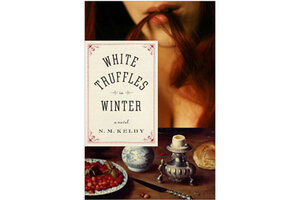White Truffles in Winter
An opulent novel based on the life of Auguste Escoffier, the 'king of chefs and chef of kings.'

White Truffles in Winter
By N. M. Kelby
Norton, W. W. & Company
352 pp
If you don't mind salivating while you read, White Truffles in Winter, N. M. Kelby's opulent novel based on the life of Auguste Escoffier, the "king of chefs and chef of kings," is about as sumptuous a work of fiction as you're likely to find. The sensuous connection between cooking, eating, and romance has been explored in fiction before, but rarely has a novel – including those by that old foodie Honoré de Balzac, or Laura Esquivel's "Like Water for Chocolate" (1989) – packed more calories and cholesterol into every page. We're talking seriously extravagant comestibles here, far more than just body-fuel.
Like a cook who refuses to follow a recipe slavishly, Kelby improvises with the basic ingredients of Escoffier's life to create a delectable dish of her own. She's occasionally heavy-handed with her seasonings – adding too many over-sweetened sentences like "Only food can speak what the heart feels" – but this is generally counterbalanced by the tart freshness of her characters, chief among them her version of the chef himself. As Kelby comments in her end note, "Escoffier's cookbooks, memoir, letters and the articles about him created the voice of this character but we all know that I did not write about the real man. The elegant savage found in these pages is who we all are when we address the plate. The magician, the priest, the dreamer, the artist – it is our most hungry self."
Yet she makes good use of the ingredients in Escoffier's biographical larder: The son of a Provence blacksmith, the future chef was born in 1846 and, after an apprenticeship in a relative's restaurant in Nice, went on to methodically reinvent modern restaurant dining. Although his elaborate menus – several of which Kelby reprints in full – look anything but simple, reduction was his byword. Working with César Ritz at the Savoy and later at the Ritz and Carlton hotels in Paris and London, he replaced the ostentatious food displays of traditional French cooking with tightly planned, choreographed menus focused on seasonal foods and lighter sauces made of reductions. These were served à la Russe, meaning one dish at a time, rather than à la Francaise, all at once, as had been the custom.
He also reorganized restaurant kitchens, dividing his brigade de cuisine into specialized food-stations (fryers, fish cooks, sauciers, salad-makers, and so on), who built meals with assembly-line efficiency.
Cherry-picking choice tidbits from Escoffier's "Guide Culinaire," first published in 1903, and "Ma Cuisine," published in 1934, the year before he died in Monte Carlo, at 88, Kelby makes the recipes and facts come alive by serving them up in a juicy narrative she whips up about Escoffier's relationships with the various women in his life. These include his longtime lover, Sarah Bernhardt, and his wife, the poet Delphine Daffis, from whom he lived apart for nearly 30 years before rejoining her in his retirement.
"White Truffles in Winter" opens during Escoffier's last summer. He and his wife are both dying in their grand stone manor house, La Villa Fernand, on the Cote d'Azur. After a lifetime of bad business decisions, they are broke. The chef is madly working on his memoir, "The Complete Escoffier: A Memoir in Meals," chapters of which punctuate the novel.
Meanwhile, the rapidly declining, bedridden Delphine frets that her husband has never created a dish in her honor – a fact that particularly grates because, in addition to inventing his famous Peach Melba for the diva Nellie Melba, he immortalized Bernhardt with several fabulous dishes, including Potage Sarah Bernhardt, a chicken consommé with crayfish quenelles and a julienne of black truffles and asparagus tips. Delphine enlists the help of their insolent young cook, Sabine, a dead ringer for Bernhardt – and presumably a wholly fictional creation – to try to wring a new recipe out of "the old goat." Escoffier, for his part, has other plans: to teach Sabine the difference between cooks and chefs, and between ordinary and sublime cuisine.
Kelby deftly weaves back and forth through time, propelled by her couple's meandering memories. Delphine dreams of "the first days of their marriage," when Escoffier commanded her to close her eyes – because "Food demands complete submission" – before placing "a perfect scallop in her mouth" and asking her, "Do you taste the sea?" Escoffier's mind wanders back to his first meeting with "the eighth wonder of the world, the Divine Sarah Bernhardt," and to less happy memories of private feasts cooked for France's once and future enemy, Emperor Wilhelm II.
The portrait that emerges of this master chef who coined the word "deliciousness" for the fifth taste (later labeled by Japanese chemists as "umami") is broad enough to encompass his various charities, his shady dealings with suppliers, his spinelessless with national enemies, and his considerable charm. But it's recipes for dishes like Crayfish Mousse – which requires drowning the crayfish in Moët before proceeding with ingredients that include a melted fish jelly "made with the finest Persian caviar and a dry white champagne of unquestionable quality, such as the Moët, but do not use the same Moët that you have used to take the life of the crayfish, as their tears add too much salt" – that make "White Truffles in Winter" such a satiating read.
Heller McAlpin, a frequent contributor to Christian Science Monitor, reviews books regularly for NPR.org and The Washington Post, among other publications.
